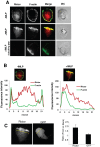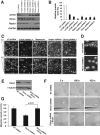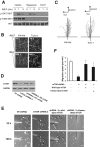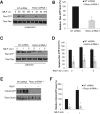Mammalian target of rapamycin and Rictor control neutrophil chemotaxis by regulating Rac/Cdc42 activity and the actin cytoskeleton
- PMID: 24006489
- PMCID: PMC3814157
- DOI: 10.1091/mbc.E13-07-0405
Mammalian target of rapamycin and Rictor control neutrophil chemotaxis by regulating Rac/Cdc42 activity and the actin cytoskeleton
Abstract
Chemotaxis allows neutrophils to seek out sites of infection and inflammation. The asymmetric accumulation of filamentous actin (F-actin) at the leading edge provides the driving force for protrusion and is essential for the development and maintenance of neutrophil polarity. The mechanism that governs actin cytoskeleton dynamics and assembly in neutrophils has been extensively explored and is still not fully understood. By using neutrophil-like HL-60 cells, we describe a pivotal role for Rictor, a component of mammalian target of rapamycin complex 2 (mTORC2), in regulating assembly of the actin cytoskeleton during neutrophil chemotaxis. Depletion of mTOR and Rictor, but not Raptor, impairs actin polymerization, leading-edge establishment, and directional migration in neutrophils stimulated with chemoattractants. Of interest, depletion of mSin1, an integral component of mTORC2, causes no detectable defects in neutrophil polarity and chemotaxis. In addition, experiments with chemical inhibition and kinase-dead mutants indicate that mTOR kinase activity and AKT phosphorylation are dispensable for chemotaxis. Instead, our results suggest that the small Rho GTPases Rac and Cdc42 serve as downstream effectors of Rictor to regulate actin assembly and organization in neutrophils. Together our findings reveal an mTORC2- and mTOR kinase-independent function and mechanism of Rictor in the regulation of neutrophil chemotaxis.
Figures






Similar articles
-
Rac and Cdc42 play distinct roles in regulating PI(3,4,5)P3 and polarity during neutrophil chemotaxis.J Cell Biol. 2003 Feb 3;160(3):375-85. doi: 10.1083/jcb.200208179. Epub 2003 Jan 27. J Cell Biol. 2003. PMID: 12551955 Free PMC article.
-
Rictor regulates cell migration by suppressing RhoGDI2.Oncogene. 2013 May 16;32(20):2521-6. doi: 10.1038/onc.2012.287. Epub 2012 Jul 9. Oncogene. 2013. PMID: 22777355 Free PMC article.
-
IKK interacts with rictor and regulates mTORC2.Cell Signal. 2013 Nov;25(11):2239-45. doi: 10.1016/j.cellsig.2013.07.008. Epub 2013 Jul 17. Cell Signal. 2013. PMID: 23872070
-
Targeted Inhibition of Rictor/mTORC2 in Cancer Treatment: A New Era after Rapamycin.Curr Cancer Drug Targets. 2016;16(4):288-304. doi: 10.2174/1568009616666151113120830. Curr Cancer Drug Targets. 2016. PMID: 26563881 Review.
-
A neutrophil-centric view of chemotaxis.Essays Biochem. 2019 Oct 31;63(5):607-618. doi: 10.1042/EBC20190011. Essays Biochem. 2019. PMID: 31420450 Review.
Cited by
-
mTORC1-S6K1 inhibition or mTORC2 activation improves hippocampal synaptic plasticity and learning in Angelman syndrome mice.Cell Mol Life Sci. 2016 Nov;73(22):4303-4314. doi: 10.1007/s00018-016-2269-z. Epub 2016 May 12. Cell Mol Life Sci. 2016. PMID: 27173058 Free PMC article.
-
UBE3A-mediated p18/LAMTOR1 ubiquitination and degradation regulate mTORC1 activity and synaptic plasticity.Elife. 2018 Jul 18;7:e37993. doi: 10.7554/eLife.37993. Elife. 2018. PMID: 30020076 Free PMC article.
-
Mir20a/106a-WTX axis regulates RhoGDIa/CDC42 signaling and colon cancer progression.Nat Commun. 2019 Jan 10;10(1):112. doi: 10.1038/s41467-018-07998-x. Nat Commun. 2019. Retraction in: Nat Commun. 2023 Sep 18;14(1):5772. doi: 10.1038/s41467-023-41612-z. PMID: 30631060 Free PMC article. Retracted.
-
Inhibitory Effects and Mechanism of the Natural Compound Diaporthein B Extracted from Marine-Derived Fungi on Colon Cancer Cells.Molecules. 2022 May 5;27(9):2944. doi: 10.3390/molecules27092944. Molecules. 2022. PMID: 35566295 Free PMC article.
-
Novel roles of mTORC2 in regulation of insulin secretion by actin filament remodeling.Am J Physiol Endocrinol Metab. 2022 Aug 1;323(2):E133-E144. doi: 10.1152/ajpendo.00076.2022. Epub 2022 Jun 20. Am J Physiol Endocrinol Metab. 2022. PMID: 35723227 Free PMC article.
References
-
- Alessi DR, James SR, Downes CP, Holmes AB, Gaffney PR, Reese CB, Cohen P. Characterization of a 3-phosphoinositide-dependent protein kinase which phosphorylates and activates protein kinase Balpha. Curr Biol. 1997;7:261–269. - PubMed
-
- Andrew N, Insall RH. Chemotaxis in shallow gradients is mediated independently of PtdIns 3-kinase by biased choices between random protrusions. Nat Cell Biol. 2007;9:193–200. - PubMed
-
- Bayle JH, Grimley JS, Stankunas K, Gestwicki JE, Wandless TJ, Crabtree GR. Rapamycin analogs with differential binding specificity permit orthogonal control of protein activity. Chem Biol. 2006;13:99–107. - PubMed
Publication types
MeSH terms
Substances
Grants and funding
LinkOut - more resources
Full Text Sources
Other Literature Sources
Molecular Biology Databases
Miscellaneous

